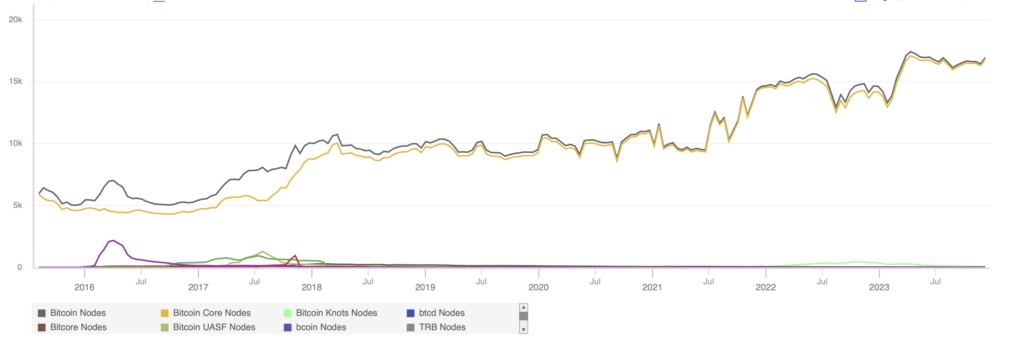 Bitcoin Core v26 goes live as 1% of nodes upgrade on launch day
Bitcoin Core v26 goes live as 1% of nodes upgrade on launch day Bitcoin Core v26 goes live as 1% of nodes upgrade on launch day
Bitcoin Core v26 rolls out with advanced features aimed at streamlining node performance and security.

Cover art/illustration via CryptoSlate. Image includes combined content which may include AI-generated content.
Bitcoin Core version 26.0 was released yesterday, Dec. 6, and 1% of Bitcoin nodes have been upgraded within the first 24 hours. This latest update to the primary software used to interact with the Bitcoin network introduces key enhancements aimed at improving security and network performance.
Bitcoin Core, often likened to the operating system for Bitcoin, ensures the rules and standards for how transactions and blocks are handled. With 99% adoption among node operators, it is the backbone of the Bitcoin network, allowing users to interact with the Bitcoin blockchain. While it hasn’t supported mining since 2016, it plays a crucial role in the Bitcoin ecosystem.
Full nodes are computers that run the Bitcoin software and maintain a copy of the entire Bitcoin blockchain. They validate transactions and blocks and relay this information to other nodes and miners, ensuring the network stays in sync. Miners, on the other hand, who create new blocks in the Bitcoin blockchain, use specialized mining software such as CGMiner.
The release of a new version of Bitcoin Core is always a significant event. However, it’s up to each node operator to decide when to upgrade. Some might upgrade immediately to take advantage of new features or improvements, while others might wait to see if any bugs or issues emerge.
The v26.0 update comes with several optimizations that improve networking connectivity and initial blockchain syncing speeds for nodes. Key features include preliminary support for a new network data transport protocol, increased resilience against eclipse attacks, faster node bootstrapping with UTXO snapshots, and a variety of RPC (Remote Procedure Calls) enhancements.
Looking ahead, developers have indicated that the forthcoming v27 update may address the alleged ‘issues’ caused by Bitcoin Ordinals—unique satoshis that have led to blockchain bloat, mempool congestion, and elevated transaction fees. However, proponents of Ordinals, including MicroStrategy’s Michael Saylor, argue that removing Ordinals would “discourage application development [… and] would also be destroying the Bitcoin mining network.”
Bitcoin Core developer Dashjr, a major critic of Ordinals, stated:
“Bitcoin Core has, since 2013, allowed users to set a limit on the size of extra data in transactions they relay or mine (`-datacarriersize`). By obfuscating their data as program code, [Ordinals] bypass this limit.”
Further, given that 44% of Bitcoin nodes are currently running on software that is over a year old, should v27.0 remove Inscriptions (Ordinals), it will be interesting to see the adoption rate of the version. Other Bitcoin software, such as Knots and btcd, are available, but adoption is minimal at present.

Bitcoin Core version distribution adoption.
The pace at which node operators upgrade to a new version of Bitcoin Core can vary significantly and is influenced by several factors. These include the perceived benefits of the new version, the stability of the new release, and the individual or organization’s resources and policies.
Historically, the adoption of new Bitcoin Core versions has been gradual. For instance, in March, Dashjr estimated that 41% of node operators had adopted and were running the latest software. Prior to the launch of v26.0, only 20% of nodes were running the latest v25.1, with 36% choosing to stick with v25.0. Further, in the five years since SegWit’s launch, half of the adoption happened after June 2021. SegWit compatibility currently sits at 95% of nodes.
Bitcoin Core v26.0 has been adopted by about 1% of nodes as of press time. This relatively slow initial adoption rate is not unusual, as node operators often take time to evaluate new releases before deciding to upgrade. They may also wait for any potential bugs or issues to be identified and resolved before adopting a new version. Currently, there are only a handful of issues listed for v26.0, none of which appear to be mission-critical, relating mostly to build problems in certain environments. However, the excitement of a new whole number Bitcoin Core version, which typically happens every 6-7 months, has attracted “general bitcoin questions” from some developers.
The process of upgrading to a new version of Bitcoin Core requires node operators to safely exit their current version and make a secure backup of their wallet.dat file before upgrading. This process can take time and resources, which may also contribute to the pace of adoption.
You can read the full release notes for Bitcoin Core here and learn how to run a Bitcoin node at home here.



 CoinGlass
CoinGlass 


 Farside Investors
Farside Investors 

























































































